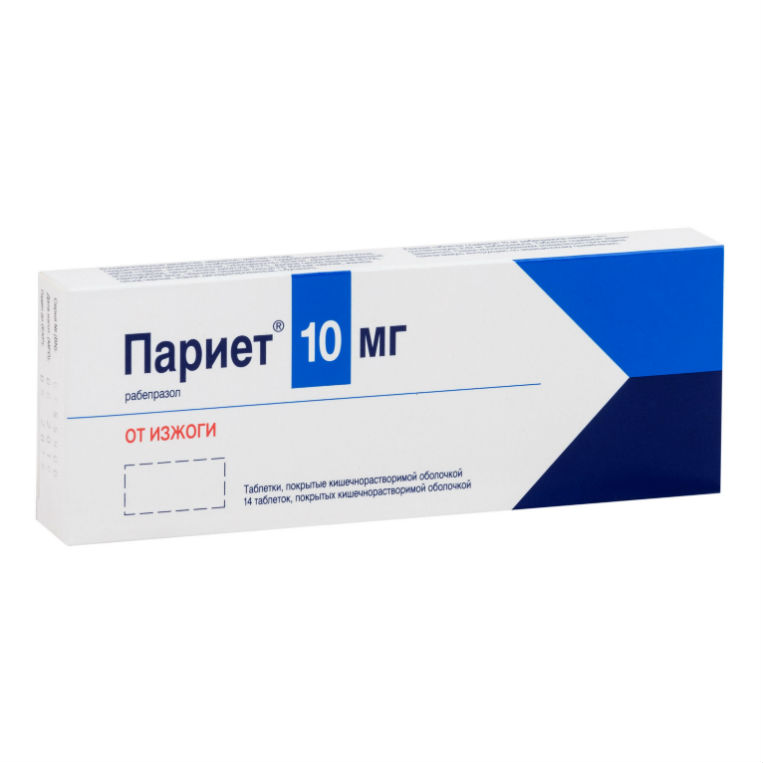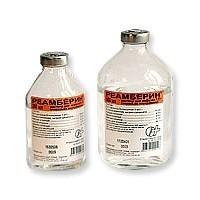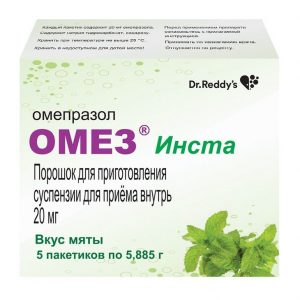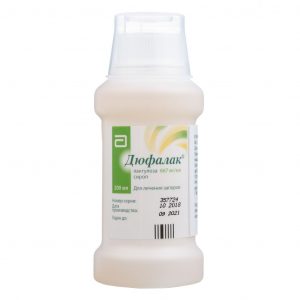Description
Latin name
Pariet
Release form
Tablets, enteric coated.
Packing
7 pcs
Indications
Symptoms of dyspepsia associated with increased acidity of gastric juice, incl. symptoms of gastroesophageal reflux disease (heartburn, sour burp).
Contraindications
Hypersensitivity to rabeprazole, substituted benzimidazoles or to auxiliary components of the
drug pregnancy and lactation period
children under 18 years of age.
Precautions: use in patients with severe renal failure.
Composition
1 tablet contains:
Active substances: rabeprazole sodium 10 mg, which corresponds to the content of rabeprazole 9.42 mg.
Excipients: mannitol (mannitol) – 26 mg, magnesium oxide – 44 mg, slightly substituted hydroxypropyl cellulose (hyprolose) – 13 mg, hydroxypropyl cellulose (hyprolose) – 4 mg, magnesium stearate – 1 mg, ethyl cellulose – 0.7 mg, hypromellose phthalate – 8.5 mg, diacetylated monoglyceride – 0.85 mg, talc – 0.8 mg, titanium dioxide (E171) – 0.43 mg, red iron oxide (E172) – 0.02 mg, carnauba wax – 0.0015 mg, food grade gray ink F6 (shellac white, black iron oxide, ethanol dehydrated, 1-butanol).
Dosage and administration
Tablets Pariet should be swallowed whole, without chewing or crushing. It was found that neither the time of day nor the meal affects the activity of rabeprazole sodium.
In case of peptic ulcer in the exacerbation phase and ulcer of the anastomosis
It is recommended to take orally 10 mg or 20 mg 1 time / day. Usually, cure occurs after 6 weeks of therapy, but in some cases, the duration of treatment can be increased by another 6 weeks.
For peptic ulcer in the exacerbation phase
The drug is recommended to be taken in a dose of 20 mg 1 time / day. In some cases, the therapeutic effect occurs when taking the drug at a dose of 10 mg 1 time / day. The duration of treatment is from 2 to 4 weeks. If necessary, the duration of treatment can be increased by another 4 weeks.
In the treatment of erosive GERD or reflux esophagitis
is recommended to be taken orally at 10-20 mg once a day. The duration of treatment is from 4 to 8 weeks. If necessary, the duration of treatment can be increased by another 8 weeks.
With maintenance therapy for GERD
It is recommended to be taken orally at 10 20 mg 1 time / day. The duration of treatment depends on the patient’s condition.
With NERD without esophagitis
It is recommended to take the drug orally at 10-20 mg 1 time / day. If after 4 weeks of treatment the symptoms do not disappear, an additional examination of the patient should be carried out. After stopping the symptoms, to prevent their subsequent occurrence, the drug should be taken orally at a dose of 10 mg 1 time / day as required.
For the treatment of Zollinger-Alison syndrome and other conditions characterized by pathological hypersecretion
, the dose is selected individually. The initial dose is 60 mg / day, then the dose is increased and the drug is prescribed in a dose of up to 100 mg / day with a single dose or 60 mg 2 times / day. For some patients, fractional dosing of the drug is preferred. Treatment should continue as needed. In some patients with Zollinger-Alison syndrome, the duration of treatment with rabeprazole was up to 1 year.
For the eradication of Helicobacter pylori
, it is recommended to take 20 mg orally 2 times / day according to a specific scheme with the appropriate combination of antibiotics. The duration of treatment is 7 days.
Dose adjustment is not required in patients with renal failure.
In patients with mild to moderate hepatic insufficiency, the concentration of rabeprazole in the blood is usually higher than in healthy patients.
Caution should be exercised when prescribing the drug Pariet to patients with severe liver failure.
Elderly patients do not require dose adjustment.
Children
Safety and efficacy of rabeprazole sodium 20 mg for short-term (up to 8 weeks) treatment of GERD in children 12 years of age and older is confirmed by extrapolation of the results of adequate and well-controlled studies confirming the effectiveness of rabeprazole sodium for adults and safety and pharmacokinetics studies for patients children’s age. The recommended dose for children aged 12 years and older is 20 mg 1 time per day for up to 8 weeks. The safety and effectiveness of rabeprazole sodium for other indications have not been established for pediatric patients.
Safety and effectiveness of rabeprazole sodium for the treatment of GERD in children under the age of 12 have not been established.
Side effects of the
From the immune system: rarely – acute systemic allergic reactions.
From the hemopoietic system: rarely – thrombocytopenia, neutropenia, leukopenia.
From the side of metabolism: rarely – hypomagnesemia.
From the hepatobiliary system: increased activity of hepatic enzymes rarely – hepatitis, hepatic encephalopathy.
From the urinary system: very rarely – interstitial nephritis.
From the skin and subcutaneous tissues: rarely – bullous rashes, urticaria very rarely – erythema multiforme, toxic epidermal necrolysis, Stevens-Johnson syndrome.
From the musculoskeletal system: rarely – myalgia, arthralgia.
From the reproductive system: very rarely – gynecomastia.
Drug Interaction
Cytochrome P450 System
Rabeprazole sodium, like other proton pump inhibitors (PPIs), is metabolized by the involvement of the cytochrome P450 (CYP450) system in the liver. In vitro studies on human liver microsomes have shown that rabeprazole sodium is metabolized by the CYP2C19 and CYP3A4 isoenzymes. Studies in healthy volunteers have shown that rabeprazole sodium does not have pharmacokinetic or clinically relevant interactions with drugs that are metabolized by the cytochrome P450 system – warfarin, phenytoin, theophylline, and diazepam (whether or not metabolized or weakened). A study of combination therapy with antibacterial drugs was conducted. This four-way cross-sectional study involved 16 healthy volunteers who received 20 mg of rabeprazole, 1000 mg of amoxicillin, 500 mg of clarithromycin, or a combination of these three drugs (CANCER: rabeprazole, amoxicillin, clarithromycin). The AUC and Cmax rates for clarithromycin and amoxicillin were similar when compared to combination therapy with monotherapy. AUC and Cmax for rabeprazole increased by 11% and 34%, respectively, and for 14-hydroxy-clarithromycin (the active metabolite of clarithromycin) AUC and Cmax increased by 42% and 46%, respectively, for combination therapy compared with monotherapy. This increase in exposure for rabeprazole and clarithromycin was not considered clinically relevant.
Interactions due to inhibition of gastric juice secretion
Rabeprazole sodium exerts a steady and prolonged suppression of gastric juice secretion. Thus, interactions with substances for which absorption is pH dependent may occur. When co-administered with rabeprazole sodium, ketoconazole absorption is reduced by 30% and digoxin absorption is increased by 22%. Therefore, some patients should be monitored to resolve the need for dose adjustment while co-administered with rabeprazole sodium with ketoconazole, digoxin or other drugs for which absorption is pH dependent.
Atazanavir
A significant reduction in atazanavir exposure was observed with concomitant administration of atazanavir 300 mg / ritonavir 100 mg with omeprazole (40 mg once daily) or with atazanavir 400 mg with lansoprazole (60 mg once daily). Atazanavir absorption is pH dependent. Although co-administration with rabeprazole has not been studied, similar results are expected for other PPIs. So, Co-administration of atazanavir with proton pump inhibitors, including rabeprazole, is not recommended.
Antacids
In clinical studies, antacids were co-administered with rabeprazole sodium. No clinically relevant interactions of rabeprazole sodium with aluminum hydroxide gel or magnesium hydroxide were observed.
Food intake
In a clinical trial, no clinically relevant interactions were observed during the administration of rabeprazole sodium with low fat foods. Taking rabeprazole sodium at the same time as fat-enriched foods can delay the absorption of rabeprazole for up to 4 hours or more, but Cmax and AUC do not change.
Cyclosporine
In vitro experiments using human liver microsomes showed that rabeprazole inhibited cyclosporine metabolism with IC50 of 62 μmol, ie in concentration, 50 times the Cmax for healthy volunteers after 20 days of taking 20 mg of rabeprazole. The degree of inhibition is similar to that for omeprazole for equivalent concentrations.
Methotrexate
According to reports of undesirable effects, published pharmacokinetic studies and retrospective data, it can be assumed that concomitant administration of PPI and methotrexate (primarily in high doses) may increase the concentration of methotrexol or methotrexol / 2. However, no specific studies of the drug interaction of methotrexate with STIs have been performed.
overdose Symptoms: data on intentional or accidental overdose are minimal. No cases of severe overdose with rabeprazole were noted.
Treatment: carrying out symptomatic and supportive therapy. The specific antidote is unknown. Rabeprazole binds well to plasma proteins, so it is poorly excreted in dialysis.
Storage conditions
Store at a temperature not exceeding 25 ° C and do not freeze.
Expiration
2 years.
Active ingredient
rabeprazole
Dispensing conditions at the
pharmacy Over-the-counter
dosage form
dosage form
tablets
Bush Pharmaceuticals, Japan




